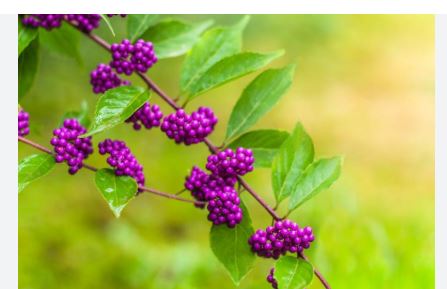
Shrubs with purple berries are a delightful addition to any garden, offering both ornamental and ecological benefits. These plants often transform into a focal point in the landscape during late summer and into the fall, when their branches become laden with clusters of vibrant, purple fruits. The color palette can range from a soft lavender to a deep, almost black shade, providing a rich tapestry of hues that contrast beautifully with the autumn foliage or the green of summer.
These shrubs support local wildlife, particularly birds. The berries serve as a critical food source during the colder months when other food might be scarce, helping to sustain bird populations through winter. Moreover, the plants themselves can support pollinators with their flowers, contributing to a healthy ecosystem.
Shrubs bearing purple berries can be used to create visual interest and texture. They can serve as standalone specimens, in mixed borders, or even as part of a hedge where their berries add a splash of color against the backdrop of leaves or other plant elements. Their versatility in landscaping also extends to their use in both formal and informal garden settings, making them adaptable to various garden styles and needs.
Shrubs With Purple Berries
American Beautyberry (Callicarpa americana)
Native to the southeastern United States, American beautyberry is a deciduous shrub that becomes a spectacle in the fall with its clusters of bright, iridescent purple berries encircling the stems. These berries are not only ornamental but also serve as a valuable food source for birds during winter.
Purple Beautyberry (Callicarpa dichotoma)
This Asian counterpart to the American beautyberry is slightly smaller but equally stunning with its dense clusters of lilac to violet berries that appear in late summer and persist into winter. It’s known for its arching branches that can create a cascading effect when laden with fruit.
Bodinier’s Beautyberry (Callicarpa bodinieri)
Originating from China, this variety is especially noted for its ‘Profusion’ cultivar, which produces a prolific display of glossy, deep purple berries. The berries contrast beautifully with the shrub’s rosy-pink fall foliage, making it a favorite for ornamental landscapes.
Velvet Leaf Shrub (Callicarpa pedunculata)
With its velvety leaves and clusters of dark purple berries, this shrub from Southeast Asia adds texture and color to gardens. It’s less commonly seen in western gardens but is becoming more popular for its unique foliage and vibrant fruit.
Purple Chokeberry (Aronia prunifolia)
This North American native shrub produces clusters of dark purple to black berries in the fall. While ‘purple’ might be a stretch, the berries start out with a purplish hue before darkening. They’re high in antioxidants and often used in jams or juice.
Purple-Fruited Viburnum (Viburnum nudum ‘Winterthur’)
Known for its showy display of berries that transition from green to a rich purple, this viburnum is native to the eastern U.S. It’s particularly valued in landscaping for autumn and winter interest, as the berries persist after the leaves have fallen.
Purple-Flowered Elderberry (Sambucus nigra ‘Black Lace’)
While elderberries typically have black berries, this cultivar stands out with its lacy, dark purple foliage and clusters of small, purplish-black berries. It’s a dramatic plant that adds depth to any garden with its foliage and fruit.
Purpleleaf Sand Cherry (Prunus x cistena)
Although primarily known for its purple leaves, this hybrid cherry also produces small, edible purple berries in late summer. These berries are sweeter than those of some other purple-fruited shrubs, making them suitable for jams or eating fresh, though they are somewhat tart.
Lantana Viburnum (Viburnum lantana)
This European native, also known as Wayfaring Tree, produces clusters of small, round berries that transition from green to a deep, almost blackish-purple as they ripen. The plant is valued for its dense growth, making it an excellent hedge plant, and its berries provide winter food for birds.
Purple-Flowered Elderberry (Sambucus canadensis ‘Aurea’)
While the ‘Black Lace’ was mentioned earlier, ‘Aurea’ is another cultivar with golden leaves, which contrast spectacularly with the clusters of dark purple to black berries it produces. These berries are edible and can be used much like the common elderberry for culinary purposes.
Purple-Flowered Beautyberry (Callicarpa kwangtungensis)
A lesser-known species from China, this beautyberry variety has smaller, more delicate berries with a soft purple hue. It’s an excellent choice for smaller gardens or as part of a mixed border where its subtle beauty can shine.
Purple-Fruited Honeysuckle (Lonicera caerulea var. emphyllocalyx)
Known also as Haskap, this shrub from Russia and Japan produces elongated, sweet-tart berries that are often bluish-purple. The variety ‘Blue Velvet’ has particularly dark, almost blackish-purple berries, which are gaining popularity for their health benefits and unique taste.
Purple-Leaved European Cranberrybush (Viburnum opulus ‘Roseum’)
While this cultivar is more famous for its sterile, showy flowers (hence ‘Snowball Tree’), it does produce small clusters of purple-black berries in fall. These berries are not as abundant as in fertile forms but still offer a splash of color.
Blackhaw Viburnum (Viburnum prunifolium)
Native to North America, this shrub produces clusters of berries that start out green and turn to a dark blue-purple when ripe. These berries are edible but not commonly used due to their astringent nature, though they are a significant food source for birds.
Purple-Flowered Serviceberry (Amelanchier canadensis ‘Purple Flash’)
Known for its foliage that turns from bronze-purple in spring to deep purple in autumn, this cultivar also produces small, sweet berries that are initially red but mature to a deep purple. These berries are popular with both humans and wildlife, especially birds.